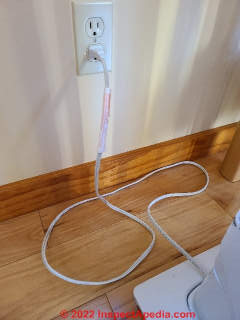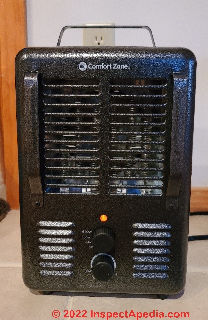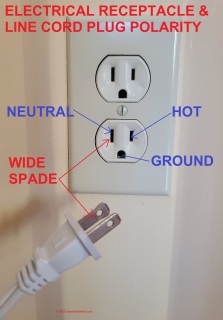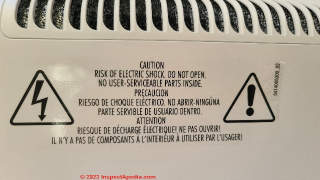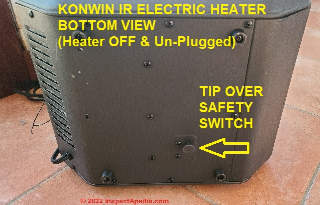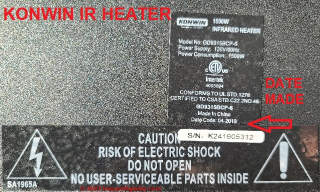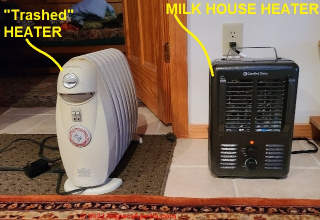 Portable Electric Heater Safety
Portable Electric Heater Safety
Advice for safe use of portable electric heaters
How to use a portable electric heater safely.
This article series describes the types of residential electric heating systems and their inspection, diagnosis & repair.
We describe each type of electric heat used in buildings and provide links to further and more detailed electric heat diagnosis & repair articles for each heater type.
InspectAPedia tolerates no conflicts of interest. We have no relationship with advertisers, products, or services discussed at this website.
- Daniel Friedman, Publisher/Editor/Author - See WHO ARE WE?
Portable Electric Heater Safety Tips
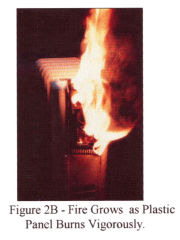 Let's review the basics of using a portable electric heater safely, avoiding fire or injury and avoiding damage to the heater itself.
Let's review the basics of using a portable electric heater safely, avoiding fire or injury and avoiding damage to the heater itself.
Photo: The plastic control panel on this portable heater has caught fire and burns vigorously - see Electro-Kindling by Aronstein, cited below on this page.
[Click to enlarge any image]
Watch out: If you ignore basic electric heater safety instructions provided by the manufacturer, you risk fire, injury, or worse, and that won't be the fault of the heater. Here we list examples of common safety suggestions found in manufacturers' literature and other sources.
- Read and follow the heater manufacturer's instructions
- Don't place the heater close to combustible materials
Don't place combustible materials like clothing or curtains within 3 ft. (1 M) of the heater's front - its heat outlet side
check the manufacturer's clearance recommendations - Don't block air flow
into or around the heater on any of its surfaces including sides and top. - Never use an extension cord
nor a power strip to power an electric heater.
These heaters are designed to be connected directly to a 120VAC (or in some countries 240VAC) wall receptacle. - Keep power cords atop carpets
When plugging in an electric heater never allow the heater's power cord to run under a carpet or rug.
At FIRE DAMAGED BUILDINGS, ASSESSMENT, REPAIR we show photos of a home that caught fire and was totally destroyed after its owner ran an electric cord under carpeting. - Examine & feel the heat of the heater's power cord and plug
and don't use the heater if the cord is visibly damaged such as cracked or cut.
Tip: When the heater has been running for 15 minutes or so, feel the line cord for signs of very high temperature, and check closely the cord where it enters the wall plug that is, in turn, plugged into the wall receptacle or "outlet" Often line cords fail at this point.
When some of the copper strands of the line cord are broken, the remaining strands have to carry more current, so may become overheated.
How hot is too hot for an electric heater power cord?
It is normal for the power cord to an electric heater to be quite warm in normal operation.
But if the cord is too to touch, in our opinion the heater is unsafe and you should turn it off and then un-plug it. Here is what DeLonghi's tower heater instructions say:
It is normal for the heater's plug and cord to feel warm to the touch. However, an excessively hot or deformed plug or cord is not normal and may be the result of a defective electrical outlet.
Defective outlets must be replaced before using the heater. Plugging the heater into a worn outlet may result in overheating of the power cord or may cause the risk of fire. - (DeLonghi 2005) - Don't connect an electric heater to a wall receptacle that is damaged,
burned, discolored, loose, hot, sparking, or making noises.
Tip: When plugging in the heater, if the wall receptacle does not grip the heater's wall plug snugly then that connection is loose and may be un-safe.
Better to plug the heater in elsewhere until you can have an electrician replace the worn wall receptacle.
Tip: If you hear buzzing, hissing, arcing, or see sparks at an electrical receptacle, stop using that circuit and turn it off at the electrical panel - there is a fire hazard.
Photo above: It's best to avoid kinking or much overlapping in the heater's power cord.
- Electric heater line cord routing
While we haven't seen this recommendation anywhere in heater manufacturer's manuals, in our OPINON the safest heater line-cord routing is one that allows the hot cord to cool and that uses the least amount of kinks or sharp bends as possible.
Photo above: this low-cost "milk house" style utility heater is made of all-metal parts and includes a "freeze-protection" setting that turns on the heater when temperatures approach freezing.
- Don't use a portable electric heater in a damp or wet area or outdoors
like a bathroom or crawlspace or wet basement unless it is designed and rated for "outdoor use" - otherwise the heater may be damaged by that moisture, leading to rust, corrosion, control failure, overheating, or other hazards.
Some of the portable electric heaters we've tested, like the Konwin IR Zone Heater described separately
at PORTABLE ELECTRIC HEATER FAILURES specifically state:
This heater is not intended for use in bathrooms, laundry areas and similar indoor locations. NEVER locate heater where it may fall into a bathtub or other water container. To protect against electrical hazards, DO NOT immerse in water or other liquids.
DO NOT touch the control panel or plug with a wet hand. - Don't use a portable electric heater in a child's room
unless you are going to be present, in the room, watching the heater.
Keep portable heaters and children apart: a child can be burned or may put something combustible too close to the heater. - Place the heater on a flat, smooth floor
A portable electric heater is designed to be placed on a flat, level surface, usually a floor, though some heaters might, if the manufacturer says it's OK, be used on a table top.
Don't put a heater on furniture like a chair, as it could fall, breaking the heater or starting a fire.
Don't defeat built-in heater safety features such as its tip-over sensor designed to turn off the heater should it fall over.
Note that the probe or button for the tip-sensor on some electric heaters uses a spring-loaded probe on the bottom of the heater. On an uneven floor or should the probe push down into a groove in a tiled floor, the heater may fail to operate. Try another location. - Don't disassemble or try to repair an electric heater yourself
unless you are a trained electrician or appliance repair person. The risk is death from electric shock or causing a building fire. - Don't let bare skin touch electric heater surfaces when the heater is hot
- you may get burned.
Really? Well yes some heater parts can get hot-enough in normal operation that they could cause a burn. - Never cover the heater with anything.
For example trying to dry a damp towel by draping it over an electric heater can cause a building fire or damage the heater. - Do not allow foreign objects
to be inserted into any of the portable electric heater's air intake or exhaust openings - you can get shocked or start a fire. - Do not use a portable electric heater in an area where gasoline, gas fumes, or inflammable liquids are present, used or stored.
The heater uses internal parts that cause arcs or sparks inside the heater in normal operation. These can ignite a combustible liquid or cause a combustible gas explosion. - When connecting or disconnecting a portable electric heater first turn its controls to OFF
this will reduce the risk of arcing or sparking at the wall receptacle. - Do not try to control this heater or connect it through a third-party device like a solid-state variable speed control device.
Doing so can cause heater malfunction and risks a fire.
- Use a polarized wall receptacle for heaters that use a polarized line-cord plug
Most modern portable electric heaters use a polarized plug: one blade is wider than the other.
The wider blade is meant to fit ONLY in the wider slot of a polarized wall electrical receptacle.
If you modify the plug or use an adapter that might allow the heater to be plugged in "backwards" the heater is unsafe and could cause an electric shock.
Note that 240V electric appliances do not use a polarized wall receptacle.
Details are at ELECTRICAL WALL PLUG WIRING ID & CONNECTIONS - Don't leave an electric heater plugged-in and running in an un-attended area.
Really? This is safe advice from NAHM, but in fact we observe the common un-attended use of electric heaters:
Electric heater left in a crawl space, well pit, or plumbing area, set at a low heat, to prevent freeze damage.
Electric heater left on in an occupied building or room as occupants sleep.
Some alternative methods of freeze protection are
at WINTERIZE - HEAT ON PROCEDURE - Plug the portable electric heater into a dedicated electrical receptacle
or "outlet" to avoid overheating the electrical circuit wiring - a potential fire hazard.
Really? This is advice from AHAM, an industry association. In six decades of lab and field work we have never found a consumer who followed this advice nor even knew how to follow it.
A 1500 Watt electric heater, running on HIGH will consume about 12.5 Amps, leaving a small un-used reserve on a typical residential 15-A 120VAC electrical receptacle circuit.
Running the same heater on a lower setting such as 1300 W - if such a feature is available - drops the current usage to a little under 11A on a 120VAC circuit.
- Disconnect the portable electric heater when it's not in use
by grasping the plug itself (not the line cord) and pulling it out of the receptacle.
Really? This advice is also from AHAM. It might be reasonable, but expert research has found that by far the number-one place on appliance line cords where overheating occurs is at the exact point where the line cord enters the wall plug itself.
Repeated pulling and tugging on the heater, wiggling the plug, and certainly tugging on the cord all increase the risk of dangerous overheating at the wall plug. - Vaccum out / remove dust from the heater
Any portable heater, especially ones that use an internal fan, will accumulate house dust at the heater's air-inlet grille and possibly even in the heater's interior space.
OPINION: Thick accumulations of dust in an electric heater dan become a fire hazard because the dust blocks airflow (causing the heater to operate at higher internal temperatures) and because in extreme cases the dust might be ignited.
When you see an accumulation of dust on the heater's inlet openings, with the heater un-plugged and cool, use a household vacuum cleaner to vacuum out and off as much of that dust as you can.
DO NOT however try to dis-assemble the heater for cleaning. Doing that is dangerous and is prohibited by the manufacturers, virtually all of whom tell you in three languages to keep your fingers and tools out of the heater's interior. (See photo below).
Portable Electric Heater Built-in Safety Devices
Heater Tip-Over Safety Switch
Many portable electric heaters include a safety device that will shut off the heater if it detects that the heater has tipped-over.
Designs for these devices vary and might include
- a spring-loaded plunger-switch on the heater bottom - shown above
- an electro-mechanical swing switch found inside the heater cabinet
- a mercury type switch found inside the heater cabinet - in the Milk House heater earlier on this page
Watch out: Heaters that use a bottom plunger switch must be on a level surface for the switch to work reliably. We found that the Konwin heater shown above, when placed on a ceramic tile floor, would switch off if the heater happened to be positioned so that its switch probe was right over a tile grout joint.
When to Stop Using a Portable Electric Heater
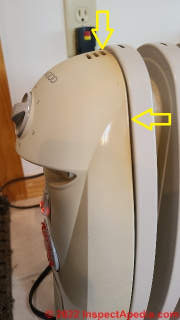 If for any reason your portable electric heater makes you nervous, un-plug it and stop using it until you've resolved the question by help from the heater's manufacturer, your local electrician, or another expert.
If for any reason your portable electric heater makes you nervous, un-plug it and stop using it until you've resolved the question by help from the heater's manufacturer, your local electrician, or another expert.
Here are examples of reasons to stop using an electric heater
- If the heater has been damaged or dropped, stop using it.
Contact the heater manufacturer for return or repair or inspection advice. - If you see burnt-looking parts on the electric heater, particularly plastic parts such as those shown in our photo or a cut, damaged, cracked, power cord or wall plug.
Details are at PORTABLE ELECTRIC HEATER FAILURES - If the heater's fan suddenly becomes noisy, rattling, buzzing
There is risk that the fan will come loose in the heater, become blocked, stop working, and the heater may over-heat. - If the heater's fan or temperature controls stop working
There is risk that the heater may over-heat and catch fire or start a fire if its normal controls or fan no longer work.
The heater in our photo was one of two that we abandoned. This one had brown plastic parts and its sister had a timer motor that buzzed and was soon to fail completely. - If the heater trips the circuit breaker or blows a fuse,
it may be that the circuit is overloaded. Don't use the heater on that circuit or unplug other things connected to that circuit. - If the heater trips the circuit breaker or blows a fuse when it is the only device on the circuit,
stop using the heater and if the breaker or fuse trips or blows again, stop using that circuit and get help from a licensed electrician.
- The electric heater has reached its anticipated safe service life.
Don't continue to use a portable electric heater past its manufacturer-recommended or anticipated safe life expectancy, typically 5-8 years.
Really? We have not found a single person who monitors the age of their electric heater nor who will toss it out based only on its age. But this age warning does appear in industry literature as well as in other sources we cite in this article.
In our OPINION, an electric heater needs to be designed to operate safely while considering the normal behavior of consumers who don't monitor heater age.
In reading the instructions provided with the electric heaters discussed in this article series, we found that a portable electric heater typically is sold with a one-year limited manufacturer warranty against defects in materials and workmanship on functional parts. That's one year from the date of purchase.
Not one of the heater manuals that we found and reviewed included a statement giving the recommended, or allowed useful life of the heater.
Research on Portable Electric Heater Safety
- AHAM, PORTABLE ELECTRIC SAFETY TIPS [PDF] AHA, Association of Home Appliance Manufacturers, 1111 19th St., NW, Ste 402, Washington DC 20036 Web: www.aham.org
AHAM is an industry trade association. - Aronstein, J., P.E. Ph.D., ELECTRO KINDLING: Easily-Ignited Free-Burning Plastic Materials in Electrical Applications [PDF] (1996) [Photo above]
- Butturini, Randy P.E., FLUX MAPPING of RADIANT ELECTRIC HEATERS [PDF] (2005) U.S. CPSC,
Excerpts:
The U.S. Consumer Product Safety Commission (CPSC) staff reports that in 1999, electric heaters were associated with an estimated 4600 fire incidents 1 . Those incidents resulted in approximately 50 deaths, 290 injuries, and $109.8 million of property loss.
The cause of many of the incidents is reported to be heaters too close to combustible materials. Since air heaters do not raise a material’s surface temperature to its ignition point, it is possible that a significant portion of the incidents involved radiant electric heaters.
Radiant heaters possess characteristics that are different from other types of room heaters. While most fan-forced and natural-convection heaters create warm air, radiant heaters primarily generate infrared (IR) radiation. This radiation impinges on objects in front of the heater and warms their surfaces.
Heaters that create warm air cannot raise the temperature of an object in the air flow path above the exhaust temperature, typically between 100° and 200° Celsius. Radiant heaters transfer heat proportional to the 4th power of the absolute temperatures of the heat source and the heat sink.
The heating element of a radiant electric heater reaches temperatures of 100s of degrees Celsius.
The Underwriters Laboratories Inc. (UL) voluntary standards UL 1278 Movable and Wall-or Ceiling-Hung Electric Room Heaters, and UL 2021 Fixed and Location-Dedicated Electric Room Heaters, define a radiant heater as one with a “visibly glowing element,” whose visible portion attains a temperature of at least 650 °C (923 K).
No upper limit for heating element temperature is specified in the voluntary standards.
Element temperatures this high insure a high energy flux from the heater into its environment. Reflections from shiny surfaces behind the heating element add to the total flux impinging on an object in front.
Consequently, the possibility exists that common combustibles in proximity to a radiant heater can be heated to ignition. Air heaters avoid igniting combustibles in two ways. First, no commonly-found materials ignite at the air temperatures exhausted by the heater. Second, air itself possesses a low heat capacity and is not effective in transferring large amounts of energy onto objects.
Radiant energy transmission is capable of continuing to heat an object’s surface until its temperature approaches that of the heating element.
With ignition temperatures ranging from 233 °C for paper to 590 °C for wool 3 , there is the prospect for materials with high emissivities and high geometric view factors to absorb enough IR energy to ignite. - Campbell, Richard B. Home Fires Involving Heating Equipment. Quincy, Massachusetts: National Fire Protection Association, 2016.
Excerpt:
… heaters were responsible for 12% and 10% of home fires … - Faith, Nicholas. Blaze: the forensics of fire. Macmillan, 2000.
- Hosamani, Anand K., Bharat Naik, Shirish M. Kerur, Vinayak Ratan, Chandra Bhushan, L. Girisha, and Yash Anvekar. "Design and Development of Portable Electrical Resistance Furnace." In IOP Conference Series: Materials Science and Engineering, vol. 1065, no. 1, p. 012016. IOP Publishing, 2021.
- LaRue, Dean L., Fire Indicators, Engineering Project Report, U.S. Consumer Product Safety Commission, Directorate for Engineering Sciences, August 2002. http://www.cpsc.gov/LIBRARY/FOIA/FOIA03/os/fip2003.pdf
- Leff, Harvey S. "Kerosene vs. Electric Portable Heaters: The Question of Risk." Environment: Science and Policy for Sustainable Development 26, no. 2 (1984): 31-36.
Excerpt:
... The Electric Alternative Portable electric heaters with heat rates of up to 1.65 kW are readily … Electric heaters can pose fire hazards if they are placed near furnishings or draperies, ... - Krawiec, Edward, CP94-1 PETITION for DEVELOPMENT of a SAFETY SETANDARD for PORTABLE ELECTRIC HEATERS [PDF] (1995) U.S. CPSC
- Miller, David, Smith, Michael, Green, Linda, 1999 Residential Fire Loss Estimates, U.S. Consumer Product Safety Commission, Directorate of Epidemiology, November, 2003 http://www.cpsc.gov/LIBRARY/fire99.pdf
- US CPSC FIRE SAFETY Checklist, CPSC [PDF] Consumer Product Safety Commission
- Scott, Lisa L., Fire Indicators Project Report, U.S., Consumer Product Safety Commission, Directorate for Laboratory Sciences, April, 2004.
...
Continue reading at Xspan class="LI_Spaced"> PORTABLE ELECTRIC HEATER FAILURES or select a topic from the closely-related articles below, or see the complete ARTICLE INDEX.
Or see these
Recommended Articles
- ELECTRIC HEATER LOCATIONS
- ELECTRIC HEATER RECALLS CADET & ENCORE
- NIGHT STORAGE HEATERS & HEAT SINK RADIATORS
- PORTABLE ELECTRIC HEATER FAILURES
- PORTABLE ELECTRIC HEATER SAFETY
- ELECTRICAL RESISTANCE vs HEAT GENERATED
- NIGHT STORAGE HEATERS & HEAT SINK RADIATORS
- PYROLYSIS EXPLAINED
Suggested citation for this web page
PORTABLE ELECTRIC HEATER SAFETY at InspectApedia.com - online encyclopedia of building & environmental inspection, testing, diagnosis, repair, & problem prevention advice.
Or see this
INDEX to RELATED ARTICLES: ARTICLE INDEX to ELECTRIC HEAT
Or use the SEARCH BOX found below to Ask a Question or Search InspectApedia
Ask a Question or Search InspectApedia
Try the search box just below, or if you prefer, post a question or comment in the Comments box below and we will respond promptly.
Search the InspectApedia website
Note: appearance of your Comment below may be delayed: if your comment contains an image, photograph, web link, or text that looks to the software as if it might be a web link, your posting will appear after it has been approved by a moderator. Apologies for the delay.
Only one image can be added per comment but you can post as many comments, and therefore images, as you like.
You will not receive a notification when a response to your question has been posted.
Please bookmark this page to make it easy for you to check back for our response.
IF above you see "Comment Form is loading comments..." then COMMENT BOX - countable.ca / bawkbox.com IS NOT WORKING.
In any case you are welcome to send an email directly to us at InspectApedia.com at editor@inspectApedia.com
We'll reply to you directly. Please help us help you by noting, in your email, the URL of the InspectApedia page where you wanted to comment.
Citations & References
In addition to any citations in the article above, a full list is available on request.
- Dr. Jess Aronstein, protune@aol.com is a research consultant and an electrical engineer in Schenectady, NY. Dr. Aronstein provides forensic engineering services and independent laboratory testing for various agencies. Dr. Aronstein has published widely on and has designed and conducted tests on aluminum wiring failures, Federal Pacific Stab-Lok electrical equipment, and numerous electrical products and hazards.
Contact: J. AronsteinConsulting Engineer Bme, Msme, Ph.D., NYS. P.E. Lic. No. 39860, 909 Londonderry Ct., Schenectady, NY 12309 USA, Tel: (845) 462-6452 Email: AronsteinJesse@ieee.org - In addition to citations & references found in this article, see the research citations given at the end of the related articles found at our suggested
CONTINUE READING or RECOMMENDED ARTICLES.
- Carson, Dunlop & Associates Ltd., 120 Carlton Street Suite 407, Toronto ON M5A 4K2. Tel: (416) 964-9415 1-800-268-7070 Email: info@carsondunlop.com. Alan Carson is a past president of ASHI, the American Society of Home Inspectors.
Thanks to Alan Carson and Bob Dunlop, for permission for InspectAPedia to use text excerpts from The HOME REFERENCE BOOK - the Encyclopedia of Homes and to use illustrations from The ILLUSTRATED HOME .
Carson Dunlop Associates provides extensive home inspection education and report writing material. In gratitude we provide links to tsome Carson Dunlop Associates products and services.


